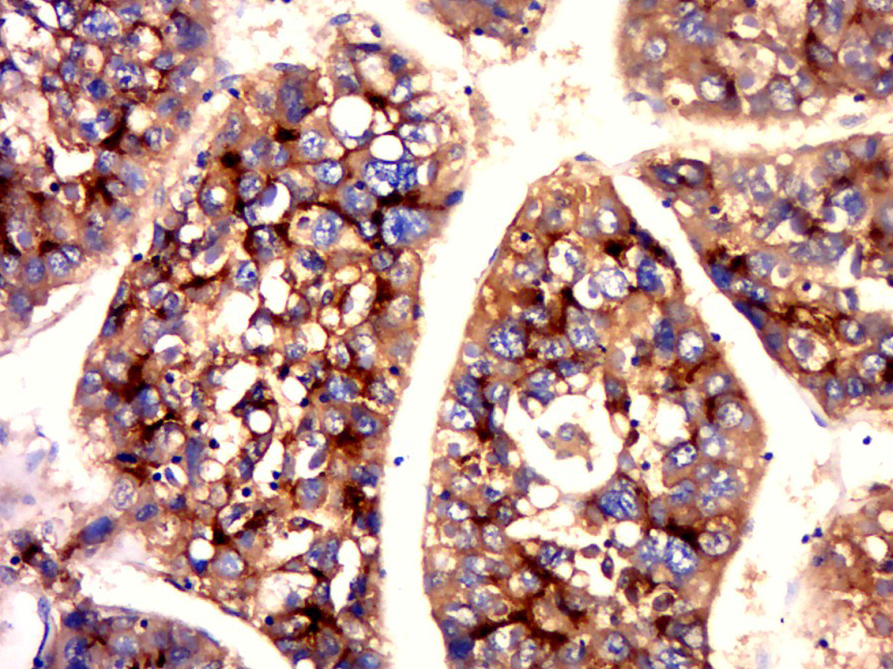
Mouse Anti-CEa (B5)antibody
Carcinoembryonic antigen; Carcinoembryonic antigen related cell adhesion molecule 5; Carcinoembryonic antigen-related cell adhesion molecule 5; CD66e; CD66e antigen; CEACAM5; CEAM5_HUMAN; DKFZp781M2392; Meconium antigen 100.
View History [Clear]
Details
Product Name CEA(B5) Chinese Name 癌胚抗原单克隆抗体(检测) Alias Carcinoembryonic antigen; Carcinoembryonic antigen related cell adhesion molecule 5; Carcinoembryonic antigen-related cell adhesion molecule 5; CD66e; CD66e antigen; CEACAM5; CEAM5_HUMAN; DKFZp781M2392; Meconium antigen 100. literatures Research Area Tumour Immunogen Species Mouse Clonality Monoclonal Clone NO. B5 React Species Human, Applications ELISA=1:5000-10000 IHC-P=1:100-500 IHC-F=1:100-500 IF=1:100-500 (Paraffin sections need antigen repair)
not yet tested in other applications.
optimal dilutions/concentrations should be determined by the end user.Theoretical molecular weight 150-200kDa Cellular localization The cell membrane Form Liquid Concentration 1mg/ml immunogen KLH conjugated synthetic peptide derived from human CEA/CD66e/CEACAM5: full length Lsotype IgG Purification affinity purified by Protein A Buffer Solution 0.01M PBS(pH7.4) with 0.03% Proclin300 Storage Shipped at 4℃. Store at -20 °C for one year. Avoid repeated freeze/thaw cycles. Attention This product as supplied is intended for research use only, not for use in human, therapeutic or diagnostic applications. PubMed PubMed Product Detail CEA-related cell adhesion molecules (CEACAM) belong to the carcinoembryonic antigen (CEA) family. It consists of seven CEACAM (CEACAM 1, CEACAM 3-CEACAM 8) and 11 pregnancy-specific glyco-protein (PSG 1-PSG 11) members. The CEA family proteins belong to the immunoglobulin (Ig) superfamily and are composed of one Ig variable-like (IgV) and a varying number (0-6) of Ig constant-like (IgC) domains. CEACAM molecules are membrane-bound either via a transmembrane domain or a glycosyl phosphatidyl inositol (GPI) anchor. CEACAM molecules are differentially expressed in epithelial cells or in leucocytes. Over-expression of CEA/ CEACAM 5 in tumors of epithelial origin is the basis of its wide-spread use as a tumor marker. The function of CEACAM family members varies widely: they function as cell adhesion molecules, tumor suppressors, regulators of lymphocyte and dendritic cell activation, receptors of Neisseria species and other bacteria.
Function:
Cell surface glycoprotein that plays a role in cell adhesion and in intracellular signaling. Receptor for E.coli Dr adhesins.
Subunit:
Homodimer. Binding of E.coli Dr adhesins leads to dissociation of the homodimer.
Subcellular Location:
Cell membrane; Lipid-anchor, GPI-anchor
Tissue Specificity:
Found in adenocarcinomas of endodermally derived digestive system epithelium and fetal colon.
Post-translational modifications:
Complex immunoreactive glycoprotein with a MW of 180 kDa comprising 60% carbohydrate.
Similarity:
Belongs to the immunoglobulin superfamily. CEA family.
Contains 7 Ig-like (immunoglobulin-like) domains.
SWISS:
P06731
Gene ID:
1048
Database links:Entrez Gene: 1048 Human
Omim: 114890 Human
SwissProt: P06731 Human
Unigene: 709196 Human
CEA是一种胚胎性抗原,主要存在于胎儿消化道上皮组织,胰腺和肝癌中。CEA广泛存在各种上皮性Tumour,尤其是胃肠道恶性Tumour,CEA分布阳性类型与Tumour的恶性度有关。CEA与EMA一样可作为上皮性恶性Tumour的重要标记。
分子量为150-200 kDa。
该抗体与SLM-1623M(检测)(Mouse Anti-Human CEA Monoclonal)配对使用;主要用于ELISA试剂盒,胶体金试剂条制备生产都很好。大量订购可来电商议。Product Picture
References (0)
No References
Bought notes(bought amounts latest0)
No one bought this product
User Comment(Total0User Comment Num)
- No comment



 +86 571 56623320
+86 571 56623320
 +86 18668110335
+86 18668110335

